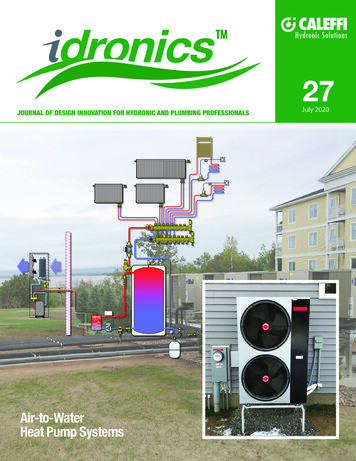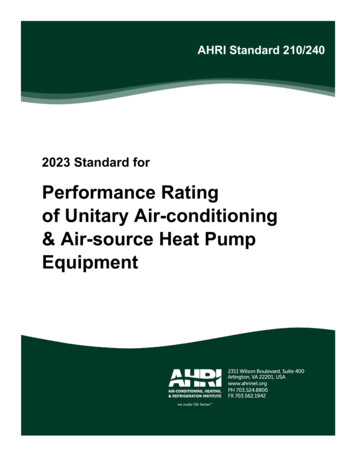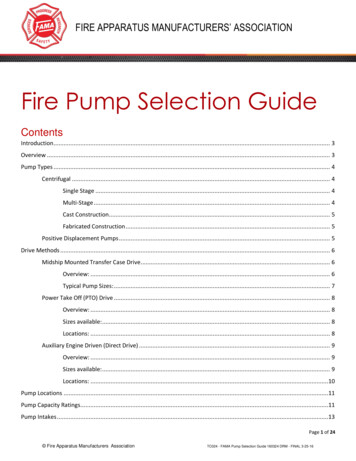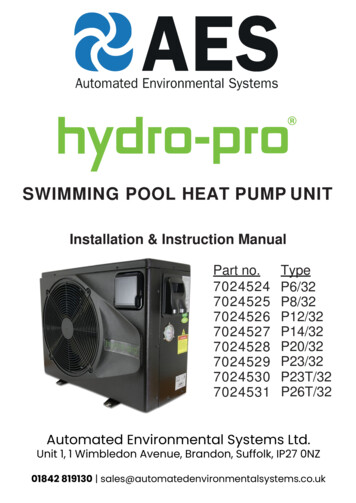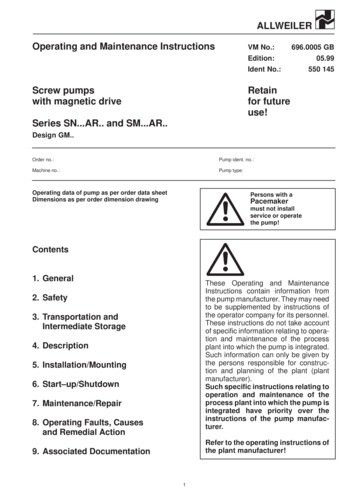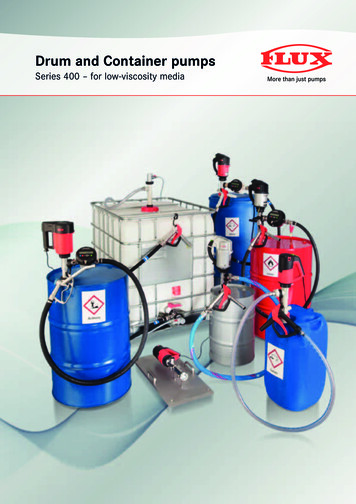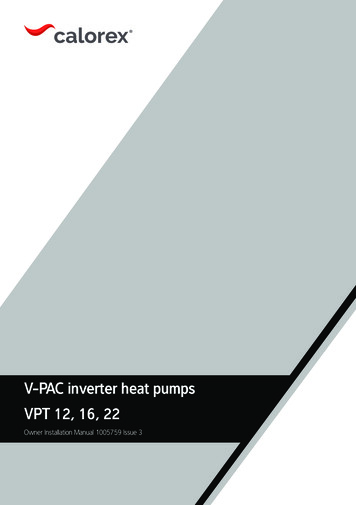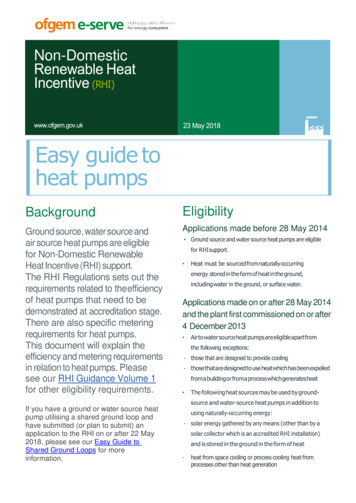
Transcription
Non-DomesticBackgroundEligibilityGround source, water source andair source heat pumps are eligiblefor Non-Domestic RenewableHeat Incentive (RHI) support.The RHI Regulations sets out therequirements related to the efficiencyof heat pumps that need to bedemonstrated at accreditation stage.There are also specific meteringrequirements for heat pumps.This document will explain theefficiency and metering requirementsin relation to heat pumps. Pleasesee our RHI Guidance Volume 1for other eligibility requirements.Applications made before 28 May 2014 Ground source and water source heat pumps are eligiblefor RHI support. Heat must be sourced from naturally occurringenergy stored in the form of heat in the ground,including water in the ground, or surface water.Applications made on or after 28 May 2014and the plant first commissioned on or after4 December 2013 Air to water source heat pumps are eligible apart fromthe following exceptions:- those that are designed to provide cooling- those that are designed to use heat which has been expelledfrom a building or from a process which generates heat The following heat sources may be used by groundsource and water-source heat pumps in addition toIf you have a ground or water source heatpump utilising a shared ground loop andhave submitted (or plan to submit) anapplication to the RHI on or after 22 May2018, please see our Easy Guide toShared Ground Loops for moreinformation.using naturally-occurring energy:- solar energy gathered by any means (other than by asolar collector which is an accredited RHI installation)and is stored in the ground in the form of heat-heat from space cooling or process cooling heat fromprocesses other than heat generation
Easy guide seriesA guide to heat pumpsNon-DomesticCoefficient of performance and SeasonalPerformance Factor for heat pumpsCoefficient of performance (COP)COP is defined in the Regulations as ‘the ratio of theamount of heating or cooling in kilowatts provided by aheat pump to the kilowatts of power consumed by theheat pump’. COP is determined by laboratory testing atdefined source and heat flow temperatures.Minimum requirementsRequirementPossible forms ofevidenceSeasonal Performance Factor (SPF)SPF is defined in the Regulations as ‘in relation toan air source heat pump or a ground source heatpump, the ratio of its heat output to electricityinput expressed as an average over a year’. A heatpumpwith a higher SPF will be more efficient and willdeliver more heat for each unit of electricity used.COPAt least 2.9COP confirmed bymanufacturer’s datasheetat rated conditions.Design SPFAt least 2.5For installations of 45 kWor less, section 3b of theInstaller Declarationshould be completed byyour installer.For installations greaterthan 45 kW, section 3a ofthe Installer Declarationshould be completed byyour installer and youwill need to obtain thesupporting calculationsfrom your installer andkeep these as they may bechecked at accreditationstage or at audit.What is the differencebetween ‘design SPF’ and‘SPF’?Design SPFThe design SPF will be calculated by the installer or otherappropriately qualified professional. It is theexpected heat pump efficiency considering site-specificfactors.SPFThe actual SPF is based on quarterly electrical inputand heat output measurements. All ground source,water source and air to water heat pumpinstallations submitting applications from 28 May2014 will need to measure the electrical input to theheat pump.Electricity meter readings will need to be provided everyquarter as part of your periodic data submission. Youwill not be required to carry out the SPF calculationsyourself, this will be calculated automatically. You willnot need to install any additional heat meters as partof this requirement.SPFNominimumrequirementElectricity meter readingsto be provided on aquarterly basis.How do I meter my electrical input?Where the heat pump controller has the capability to log theelectrical input this may be used. Alternatively appropriateelectricity meter(s) may be installed. Electricity metersshould be installed according to best industry practice. Yourinstaller will be able to assist you with selecting appropriatemeters.If the heat pump is capable of cooling, the measured electricalinput should be for the heating function only, if this is notoverly burdensome.Will the SPF measurements affect payments?What to do for periodic data submissionsThe design SPF is an eligibility requirement foraccreditation and must be a minimum of 2.5.Ongoingmeasurement of SPF is for monitoring purposes onlyand will not affect RHI payments.Each quarter, the kWh of electricity input to the equipmentwithin the boundary will need to be recorded.
Easy guide seriesA guide to heat pumpsWe will need to know which components are included in your measurement of electricity consumption and heat output.To do this we will ask you to tell us which of these three common system boundaries reflect your heat pump arrangements.SPFH2SPFH4SPFH2Heat PumpSource pumpelectricheaterIntegrated distribution system componentsSPFH3 SPFH3 Is my heat pump eligible?Ground source and water source heat pumps that arecapable of cooling are eligible technologies, though onlyheat generated is eligible for RHI support.Air to water heat pumps that are capable of coolingare not an eligible technology.What capacity should I enter on the RHI application form?For heat pumps capable of cooling the capacity submitted mustbe the ‘design heat load’. This is defined in the Regulationsas “in relation to ground source heat pumps that arecapable of heating and cooling, the heat flow required toachieve theplanned heating requirements for that plant”. In other words,the capacity of the heat pump associated to the heatingfunction, and not including the cooling function.Your installer should calculate your design heat load and enterthis into section 2 of the Installer Declaration. They shouldalso provide you with the supporting calculations which youmust retain as this may be checked at accreditation stage or ataudit.heat pump unitequipment required to make use of the sourceenergy, e.g. pump or fanintegrated electric heaterSPFH4 Heat pumps capableof coolingheat pump unitequipment required to make use of the sourceenergy, e.g. pump or fanheat pump unitequipment required to make use of the sourceenergy, e.g. pump or fanintegrated electric heater (if present)internal distribution system components such ascirculation pump and motorised valves.What do I need to prove?You need to ensure that your metering arrangement willnot be affected by the cooling function. You should writea statement at question HK120 of the RHI applicationform to explain how you will ensure the meters are notaffected by the cooling function. You must thendemonstrate this on your schematic by clearlydistinguishing between the heating and the coolingcircuits.Additional information for heat pumpapplications made before 28 May 2014or with a commissioning date before4 December 2013If your heat pump is capable of cooling and is goingto be transferring heat back to the ground loop duringa cooling cycle then some amount of this heat will beavailable for later use during heating operation. Thismust be deducted as it is not considered to be aneligible source of heat for applications made before28 May 2014 or where the plant is first commissionedbefore 4 December 2013.
Easy guide seriesIntegrated immersionheatersIntroductionFor the purpose of the Non-Domestic RHI, the term‘integrated immersion heater’ refers to immersion heaterswhich are incorporated within the heat pump unit itself1.This section explains the additional requirements for RHIapplicants resulting from the use of heat pumps withintegrated immersion heaters. Text in bold refers to wordingwhich will appear on the ‘Renewable Heat Incentive Register’2.A guide to heat pumpsHow can I measure heatproduced by an integratedimmersion heater?The principal two methods by which heat from anintegrated immersion heater could be measured are:1. Heat Pump Controller:Heat pumps with integrated immersion heaters are notexcluded from the RHI. However, the primary legislation whichunderpins the scheme3 only allows support for the ‘renewablegeneration of heat’. Therefore, the heat generated by theintegrated immersion heater must be appropriately accountedfor. This heat will not be eligible for RHI payments. Due to thetechnically challenging nature of measuring this heat by meansof a heat meter, alternative means of measuring the heatfrom the integrated immersion are considered acceptable.These are detailed below.1An immersion heater located within a hot water cylinder, or in-line heaterin the central heating circuit / buffer, would not be considered ‘integrated’forRHI purposes. Heat from such immersion heaters may be required tobe metered dependent on the metering classification of the installationand heating system layout.2The RHI IT system used for making applications to the schemeand submitting periodic data3The Energy Act 2008, section 100.Monthly for installations with a capacity 1 MWth45Kilowatt-electric6Otherwise in this situation we may require you to make a conservativeassumption that the maximum-rated immersion heater was in use at all times.7Since 100%of the electrical energy provided to the immersion is assumed tobe converted to heat energy.for accreditation.
Easy guide seriesA guide to heat pumpsWhat to do for periodic data submissionsEach quarter the kWhth of heat provided by theintegrated immersion heater will need to be calculated,in line with the approach outlined in your application, andsubmitted as part of your periodic data submission. Thisis made via the ‘Renewable Heat Incentive Register’.In completing this take account of the followinginstructions: The measured figure for heat produced from theintegrated immersion heater should be providedwithin the ‘Back-up heaters integral to the heat pumpsystem’ field. Subtract this figure from the metered heat from theheat pump installation for the quarterly periodic datasubmission period. Provide the result of this subtraction to the ‘Heatgenerated by the installation’ field. For complexinstallations where other plant supplying heat to theheating system have been metered, this subtractionshould not be reflected in the ‘Heat generated byall the plants supplying heat to the heating system’field.Upon accreditation any specific requirements regardingthe submission of periodic data will be communicatedby Ofgem within your conditions of accreditation.8This applies for simple or complex installations, which is only relevant to those who submitted their application before 24 September 2013.Easy guides seriesEasy Guide to the Non-Domestic RHIEasy Guide to EligibilityEasy Guide to ApplyingEasy Guide to Metering RequirementsEasy Guide to ComplianceEasy Guide to Periodic Data SubmissionsEasy Guide to SustainabilityEasy Guide to Heat PumpsGuide to Tariff GuaranteesThis Easy Guide is applicable to applicants and participants on the GB Non-Domestic scheme. If you’re an applicant orparticipant on the Northern Ireland Non-Domestic scheme then please refer to the Northern Ireland Renewable HeatIncentive.Contact usHelp is at hand if you need it. Our enquiries staff are experts on the RHI and can help advise you.Ofgem.gov.uk/RHI Telephone: 0300 003 2289 Email: rhi.enquiry@ofgem.gov.ukRHI enquiry line open Monday to Thursday 9am-5pm and to 4.30pm on Fridays. Note: Calls may be recorded.ES888
heat pump to the kilowatts of power consumed by the heat pump'. COP is determined by laboratory testing at defined source and heat flow temperatures. Seasonal Performance Factor (SPF) SPF is defined in the Regulations as 'in relation to an air source heat pump or a ground source heat pump, the ratio of its heat output to electricity

